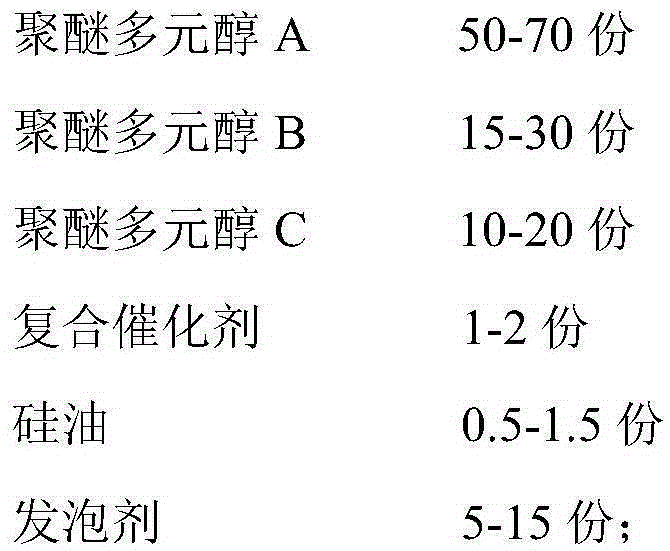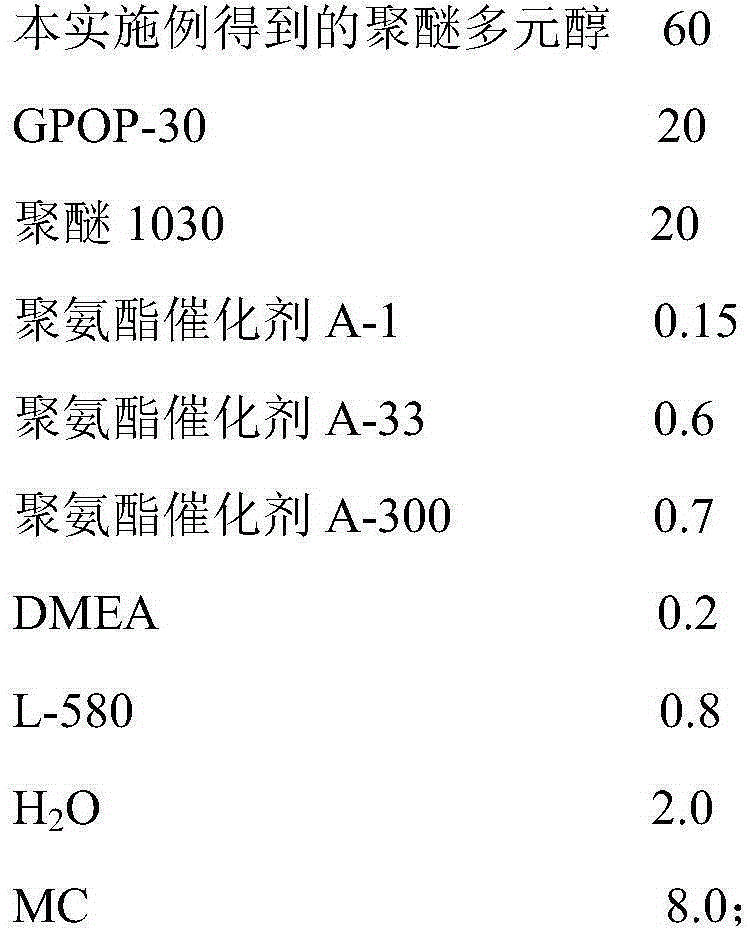Polyether polyol used for low-density gaseousness and slow-resilience foam, preparation method of polyether polyol and slow-resilience foam and preparation method thereof
A technology of polyether polyol and slow rebound, which is applied in the field of organic polymer synthesis, and can solve the problems of low density, high comfort, slow rebound foam, no moist comfort, high density of slow rebound foam, etc. It achieves the effects of simple and feasible preparation method, low depression residue and good flatulence
- Summary
- Abstract
- Description
- Claims
- Application Information
AI Technical Summary
Problems solved by technology
Method used
Image
Examples
Embodiment 1
[0035] The polyether polyol for low-density inflatable slow-rebound foam is a copolymer of propylene oxide and ethylene oxide monomers with trimethylolpropane as the starting agent and ethylene oxide as the end group. Wherein, in the polymerized monomer, propylene oxide accounts for 30 wt%, and ethylene oxide accounts for 70 wt%.
[0036] The preparation method is as follows:
[0037] (1) Add 134g of TMP and 10g of KOH into the pressure-resistant reactor, and replace with nitrogen for 3 times. After measurement, the oxygen content is 45ppm, the temperature is raised to 110°C, the vacuum is pumped to -0.092MPa, and the dehydration reaction is carried out for 5h;
[0038] (2) Continuously add 1460g of propylene oxide and 3406g of ethylene oxide monomer into the pressure-resistant reaction kettle through the proportional adjustment mixer, and carry out polymerization reaction at 120°C. After the feeding is completed, continue to react for 2h; then vacuumize to -0.092 MPa, remove...
Embodiment 2
[0049] The polyether polyol for low-density inflatable slow-rebound foam is a copolymer of propylene oxide and ethylene oxide monomers with glycerol and neopentyl glycol as initiators and ethylene oxide-terminated end groups. Wherein, in the polymerized monomer, propylene oxide accounts for 15 wt%, and ethylene oxide accounts for 85 wt%.
[0050] The preparation method is as follows:
[0051] (1) Add 61.33g of glycerol, 34.67g of neopentyl glycol, and 13.2g of NaOH to the pressure-resistant reactor, and replace it with nitrogen 4 times. After measurement, the oxygen content is 40ppm, and the temperature is raised to 110°C. -0.092MPa, dehydration reaction 7h;
[0052] (2) Continuously add 646g of propylene oxide and 3658g of ethylene oxide monomer into the pressure-resistant reactor through a proportional adjustment mixer, and carry out polymerization reaction at 120°C. After the feeding is completed, continue to react for 2h; then vacuumize to -0.092 MPa, to remove unreacted...
Embodiment 3
[0063] The polyether polyol for low-density flatulence and slow-rebound foam is a copolymer of propylene oxide and ethylene oxide monomers with glycerol and sorbitol as initiators and ethylene oxide-terminated end groups. Wherein, in the polymerized monomer, propylene oxide accounts for 5 wt%, and ethylene oxide accounts for 95 wt%.
[0064] The preparation method is as follows:
[0065] (1) Add 59.28g of glycerol, 23.45g of sorbitol and 16.4g of NaOH to the pressure-resistant reactor, and replace it with nitrogen for 5 times. It is determined that the oxygen content is 28ppm, and the temperature is raised to 110°C, and the vacuum is reduced to -0.092 MPa, dehydration reaction 8h;
[0066] (2) Continuously add 230.3g of propylene oxide and 4367g of ethylene oxide monomer into the pressure-resistant reactor through a proportional adjustment mixer, and carry out polymerization reaction at 120°C. After the feeding is completed, continue to react for 2h; then vacuumize to - 0.09...
PUM
| Property | Measurement | Unit |
|---|---|---|
| hydroxyl value | aaaaa | aaaaa |
Abstract
Description
Claims
Application Information
 Login to View More
Login to View More - R&D
- Intellectual Property
- Life Sciences
- Materials
- Tech Scout
- Unparalleled Data Quality
- Higher Quality Content
- 60% Fewer Hallucinations
Browse by: Latest US Patents, China's latest patents, Technical Efficacy Thesaurus, Application Domain, Technology Topic, Popular Technical Reports.
© 2025 PatSnap. All rights reserved.Legal|Privacy policy|Modern Slavery Act Transparency Statement|Sitemap|About US| Contact US: help@patsnap.com



